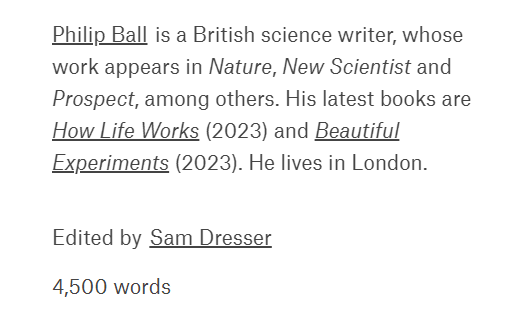Welcome to DU!
The truly grassroots left-of-center political community where regular people, not algorithms, drive the discussions and set the standards.
Join the community:
Create a free account
Support DU (and get rid of ads!):
Become a Star Member
Latest Breaking News
Editorials & Other Articles
General Discussion
The DU Lounge
All Forums
Issue Forums
Culture Forums
Alliance Forums
Region Forums
Support Forums
Help & Search
We are not machines

Welcome to the new, post-genomic biology: a transformative era in need of fresh metaphors to understand how life works
https://aeon.co/essays/we-need-new-metaphors-that-put-life-at-the-centre-of-biology


You could be forgiven for thinking that the turn of the millennium was a golden age for the life sciences. After the halcyon days of the 1950s and ’60s when the structure of DNA, the true nature of genes and the genetic code itself were discovered, the Human Genome Project, launched in 1990 and culminating with a preliminary announcement of the entire genome sequence in 2000, looked like – and was presented as – a comparably dramatic leap forward in our understanding of the basis of life itself. As Bill Clinton put it when the draft sequence was unveiled: ‘Today we are learning the language in which God created life.’ Portentous stuff. The genome sequence reveals the order in which the chemical building blocks (of which there are four distinct types) that make up our DNA are arranged along the molecule’s double-helical strands. Our genomes each have around 3 billion of these ‘letters’; reading them all is a tremendous challenge, but the Human Genome Project (HGP) transformed genome sequencing within the space of a couple of decades from a very slow and expensive procedure into something you can get done by mail order for the price of a meal for two.
Since that first sequence was unveiled in 2000, hundreds of thousands of human genomes have now been decoded, giving an indication of the person-to-person variation in sequence. This information has provided a vital resource for biomedicine, enabling us, for example, to identify which parts of the genome correlate with which diseases and traits. And all that investment in gene-sequencing technology was more than justified merely by its use for studying and tracking the SARS-CoV-2 virus during the COVID-19 pandemic. Nonetheless, as with the Apollo Moon landings – with which the HGP has been routinely compared – the decades that followed the initial triumph have seemed something of an anticlimax. For all its practical value, sequencing in itself offers little advance in understanding how the genome – or life itself – works. As the veteran molecular biologist Sydney Brenner wrote in 2010, the comparison with the Apollo programme turns out to be ‘literally correct’:

That task hasn’t turned out as expected. The copious genome databases haven’t yet produced the flood of new treatments and drugs that some had predicted from gene-based medicine, nor delivered on the promise of therapies tuned to our own individual genomes. Despite the COVID-19 vaccines, drug development as a whole has stagnated or even slowed over recent decades, becoming ever more costly. And most drugs are still found by old-fashioned trial and error, not by leveraging genetic data. The outcomes have been particularly disappointing for understanding and treating cancer, long thought to arise from changes (mutations) in the sequences in our DNA that are either inherited or accumulated through age and environmental wear and tear. Despite the genetic data glut, biology seems to have settled back into a long, slow slog.

But I think this story is wrong. Fixing life remains difficult – but, in terms of understanding it, the course of cell and molecular biology over the past several decades isn’t a tale of unfulfilled promise. On the contrary, we’re in one of the most exciting periods since James Watson and Francis Crick discovered DNA’s double helix in 1953. The transformative advances of the post-genomic decades are revealing nothing less than a new biology: an extraordinary and fresh picture of how life works. And ironically, those advances turn out to undermine the skewed view of life on which the HGP itself was predicated, in which the genome sequence of DNA was (in the words Watson put into Crick’s mouth) the ‘secret of life’.
snip
InfoView thread info, including edit history
TrashPut this thread in your Trash Can (My DU » Trash Can)
BookmarkAdd this thread to your Bookmarks (My DU » Bookmarks)
0 replies, 329 views
ShareGet links to this post and/or share on social media
AlertAlert this post for a rule violation
PowersThere are no powers you can use on this post
EditCannot edit other people's posts
ReplyReply to this post
EditCannot edit other people's posts
Rec (0)
ReplyReply to this post